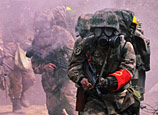
 |
| Heavy fog envelops Beijing on Sunday morning and the municipal meteorological station issues the city's first orange fog warning. [Photo/Xinhua] |
Beijing has a permanent population of around 20 million and some 5.2 million vehicles.
Pollutants, parts of which came from vehicle waste and coal burning in the chilly winter, gradually accumulated in recent windless days. The hazy weather would continue until Wednesday in Beijing, local meteorologists said.
"Such a prolonged pollution is rare in Beijing," said a university undergraduate who only gave his surname Wang. He wore a mask to "avoid pollution and flu infection."
The 22-year-old student, who has been living in Beijing since childhood, told Xinhua he expected the government to take more timely and effective actions, such as the dissemination of air pollution information and the suspension of classes for children who are vulnerable to diseases.
Doctors with the Beijing Chaoyang Hospital and the Beijing Children's Hospital said the number of patients with respiratory disease had jumped sharply in the past few days.
Starting from January 1, real-time air quality monitoring data on PM2.5 intensity in China's 74 major cities, including Beijing, is available for citizens, a move at the request of the public.
The PM2.5 index is considered stricter than the PM10 standard previously adopted in China. It measures airborne particles smaller than 2.5 micrometers, which are more hazardous to people's heath.

















 China's social trust index declined further last year, according to the Annual Report on Social Mentality of China 2012
China's social trust index declined further last year, according to the Annual Report on Social Mentality of China 2012


![]()
